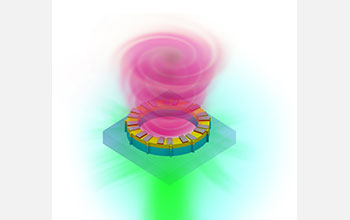Multimedia Gallery
Possible new component of next-generation computers (Image 1)
A vortex laser on a chip. Because the laser beam travels in a corkscrew pattern, encoding information into different vortex twists, it’s able to carry 10 times or more the amount of information than that of conventional lasers. The optics advancement could become a central component of next-generation computers designed to handle society’s growing demand for information sharing.
More about this image
For several decades, researchers have been able to pack more and more components onto silicon-based computer chips, which is why today's smartphones have more computing power than the world’s most powerful computers of the 1980s. But researchers are running into a problems where existing technology may no longer meet society’s demand for data and some predictions suggest this could happen within the next five years.
"To transfer more data while using less energy, we need to rethink what’s inside these machines," says Liang Feng, Ph.D., an assistant professor in the Department of Electrical Engineering at the University at Buffalo's (UB) School of Engineering and Applied Sciences, and the study’s co-lead author.
Researchers are looking at a number of ways to address this problem including optical communications -- using light to carry information.
Lasers are a central part of today’s optical communication systems and the UB-led team is pushing laser technology forward using another light manipulation technique called orbital angular momentum, which distributes the laser in a corkscrew pattern with a vortex at the center. The UB team shrunk the vortex laser to the point where it is compatible with computer chips. Because the laser beam travels in a corkscrew pattern, encoding information into different vortex twists, it’s able to carry 10 times or more the amount of information than that of conventional lasers, which move linearly.
The vortex laser is one component of many, such as advanced transmitters and receivers that will ultimately be needed to continue building more powerful computers and datacenters.
The research was supported in part by the National Science Foundation (grant DMR 15-06884).
To learn more about this research, see the UB news story Vortex laser offers hope for Moore’s Law. (Date image taken: 2016; date originally posted to NSF Multimedia Gallery: Jan. 25, 2017) [Image 1 of 2 related images. See Image 2.]
Credit: Natalia Litchinitser, University at Buffalo
Images and other media in the National Science Foundation Multimedia Gallery are available for use in print and electronic material by NSF employees, members of the media, university staff, teachers and the general public. All media in the gallery are intended for personal, educational and nonprofit/non-commercial use only.
Images credited to the National Science Foundation, a federal agency, are in the public domain. The images were created by employees of the United States Government as part of their official duties or prepared by contractors as "works for hire" for NSF. You may freely use NSF-credited images and, at your discretion, credit NSF with a "Courtesy: National Science Foundation" notation.
Additional information about general usage can be found in Conditions.
Also Available:
Download the high-resolution JPG version of the image. (2.9 MB)
Use your mouse to right-click (Mac users may need to Ctrl-click) the link above and choose the option that will save the file or target to your computer.

